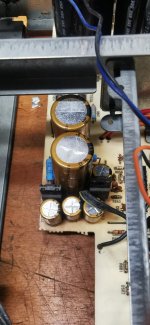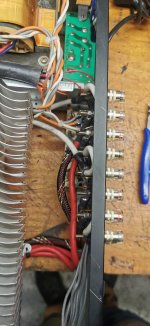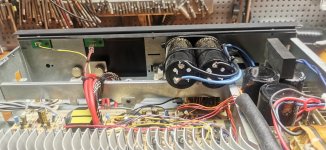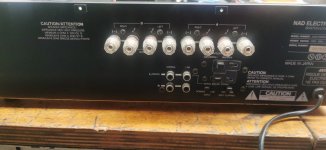Yes sorry, looks like I made the same mistake in my previous message, definitely 2SA1943/2SC5200 😉
Hehe thats ok, i just wanted to be sure.
Same trannies Nad uses in their newer amps then (270/272)
Same trannies Nad uses in their newer amps then (270/272)
Informativ thread.
Would be nice if someone could draw up the signal path as well on the schematics.
I'm just curious since I have the same issue with a 3400 amp. Changed some of the mentioned trannies, and changed 4 of the 4,7k resistors, 2 burnt...
Also wonder which caps in the signal path, might be good to change due to age.
Cheers.
Would be nice if someone could draw up the signal path as well on the schematics.
I'm just curious since I have the same issue with a 3400 amp. Changed some of the mentioned trannies, and changed 4 of the 4,7k resistors, 2 burnt...
Also wonder which caps in the signal path, might be good to change due to age.
Cheers.
Got similar issues with my 2400
Was working well, after powered up after some weeks. It went into protection.
One channel measures aprox 70 vdc everywhere.... Not sure how to start
Was working well, after powered up after some weeks. It went into protection.
One channel measures aprox 70 vdc everywhere.... Not sure how to start
Seems like you have some output transistors shorted. Put multimeter to diode check and check voltagedrop in all directions, left to right etc, if you get 0.5-0.7V between they should be ok. Usually when a pair or more blows there is either or a big 2-5w resistor blown near it and usually some smaller resistor aswell. Many times it also blows transistor that sits before the ones blown so the schematic is your friend here. If you replace them take care to put amp through a lampbulb (old fashioned type 100-200W) before… also bias needs to be readjusted etc so not maybe very easy if you havent done it before.
A guy here in Helsinki, Finland repairs many hifi amps and some kind of specialist on NAD also so you can send it to him if nobody can fix it there. His company is called RAD, Radikal Akustik Design. I know many people who sent him stuff. He also does serious upgrades
A guy here in Helsinki, Finland repairs many hifi amps and some kind of specialist on NAD also so you can send it to him if nobody can fix it there. His company is called RAD, Radikal Akustik Design. I know many people who sent him stuff. He also does serious upgrades
I've attached a service manual and think the schematics are slightly better than those attached in posts 4 and 5.
I agree that failed output transistors are the most likely culprits but I also like to pursue powered troubleshooting. I regard the amp as an opamp and measure voltages at the input differential stage (+ input and - feedback at the bases of Q401 and Q401) and amp output. Feedback is set by R412 and R411. Given that output is stuck at +70V, does the feedback to the differential pair look right? Higher than the input bias? Then follow circuit voltages, stage by stage. Negative feedback should be attempting to drive the amp toward 0V. Somewhere along the path a failed component doesn't respond the the feedback impetus. At that point you're near the defect. The idea is to avoid removing components until you find a part that's not behaving. Less laborious and less risk of damage.
Good luck.
I agree that failed output transistors are the most likely culprits but I also like to pursue powered troubleshooting. I regard the amp as an opamp and measure voltages at the input differential stage (+ input and - feedback at the bases of Q401 and Q401) and amp output. Feedback is set by R412 and R411. Given that output is stuck at +70V, does the feedback to the differential pair look right? Higher than the input bias? Then follow circuit voltages, stage by stage. Negative feedback should be attempting to drive the amp toward 0V. Somewhere along the path a failed component doesn't respond the the feedback impetus. At that point you're near the defect. The idea is to avoid removing components until you find a part that's not behaving. Less laborious and less risk of damage.
Good luck.
Attachments
Tnx for replying.
I'm not so experienced reading and understanding all aspects in the schematics...
Last time I checked, I couldn't measure anything wrong with output tr... Or other transistors around. But will do another test when I'm home.
I'm stuck offshore on a boat, so I'm spending time reading and get some advise how to proceed.
Now I have 2 off these 2400 ampsy, and was hoping to bridge them and use together with a Nad 1700
I'm not so experienced reading and understanding all aspects in the schematics...
Last time I checked, I couldn't measure anything wrong with output tr... Or other transistors around. But will do another test when I'm home.
I'm stuck offshore on a boat, so I'm spending time reading and get some advise how to proceed.
Now I have 2 off these 2400 ampsy, and was hoping to bridge them and use together with a Nad 1700
This is what i substituted the grilled 4,7k resistors with: 4,7k Dale metal film resistors, 1W. 🙂

A good idea is to also upgrade the hard toasted 22k resistors: R030 and R034. I am working with the NAD 7400 reciever, and thats exactly the same amplifier board as in the 2400.

Last edited:
I'm looking to upgrade my 2400's..
Looked through quirk audio, and tried to make a list with caps to order.
Anyone here did this upgrade?
Just some pics for attention...
Better terminals and thicker wiring from relay to terminals.
2 xtra caps on the 100 volt rail.. Not sure if it have any effect, but they was laying around so better use them... Maybe better to have them on the 80 volt rail?
Looked through quirk audio, and tried to make a list with caps to order.
Anyone here did this upgrade?
Just some pics for attention...
Better terminals and thicker wiring from relay to terminals.
2 xtra caps on the 100 volt rail.. Not sure if it have any effect, but they was laying around so better use them... Maybe better to have them on the 80 volt rail?
Attachments
My thinking in that matter (adding PSU caps) is:
The ”low” voltage rails is the most important for everyday Sound Quality, since it is where you gonna be the absolute majority of the time playing music up to very loud. But, when you really wanna crank it up close to the absolute top: The high volt rails also gonna like some added caps.
🙂
The ”low” voltage rails is the most important for everyday Sound Quality, since it is where you gonna be the absolute majority of the time playing music up to very loud. But, when you really wanna crank it up close to the absolute top: The high volt rails also gonna like some added caps.
🙂
Hi - I picked up a pair of NAD 2400 thx power envelope model recently - one of them reads a bias of 22-24 mv on the channels, the other one reads 8 mv bias on both channels - they both sound just fine - I read somewhere the bias should be around 14mv on the channels - is it worth tweaking them just a bit ? What’s the benefit of having correct bias ?
It will sound better with higher bias, in your case i would adjust both channels to same, 15-18mw otherwise it might overheat. Depends what you drive them to and levels.. if you know you never crank it much and not going mono (biamp will provide better sound) i will keep 20-22mv on both. Otherwise with mono and high volume keep it to 14mw.
Ah ok.. so best to be left alone for now on the second amp with the 8mv bias on the channels aince it may have drifted lower due to other issues - I don’t drive them too hard so I’ll leave the one amp with the 22 and 24 on the channels as is - guess eventually when recapped better to adjust then ?
- Home
- Amplifiers
- Solid State
- NAD 2400 problem - need help



